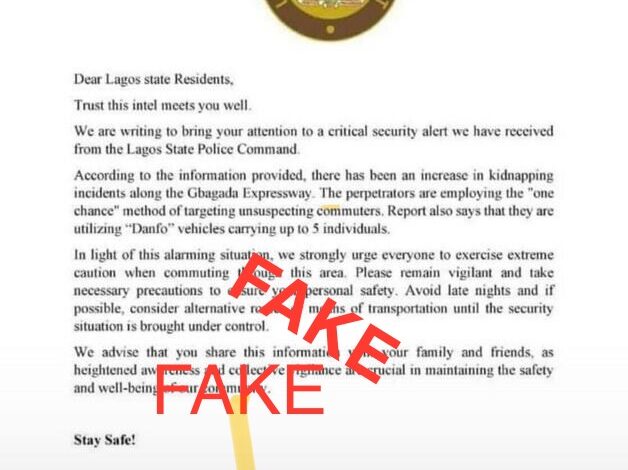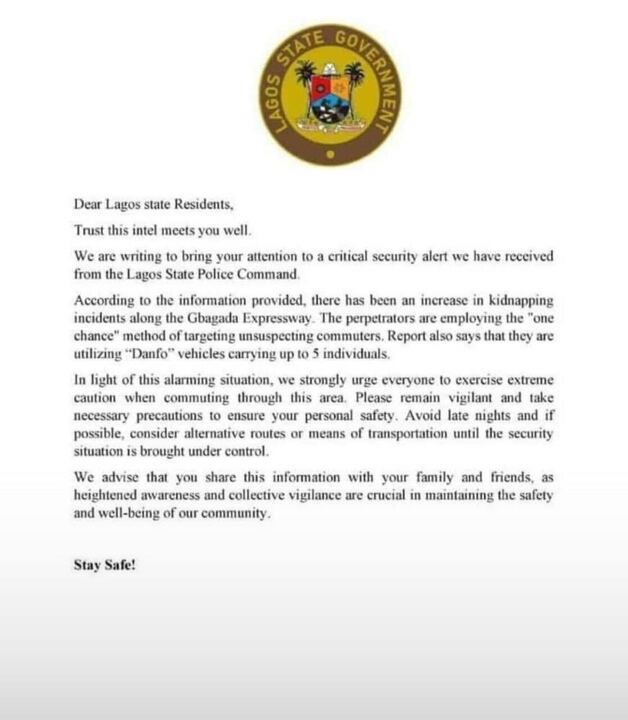
BY: Oluwaseye Ogunsanya
Claim
A memo alleging that the Lagos State government received a “critical security alert” from the police command regarding abductions on the Gbagada expressway is circulating on WhatsApp.
Verdict
False.
Full Text
A memo alleging that the Lagos State government received a “critical security alert” from the police command regarding abductions on the Gbagada expressway is circulating on WhatsApp.

Screenshot of the WhatsApp claim with the ‘forwarded many times’ tag
The memo which bore no date nor signature claimed that there has been an increase in kidnapping incidents along the Gbagada expressway, adding that the perpetrators were using “one chance” tactics and Danfo buses to target commuters.

Photo Credit: Screenshot of the claim
“We are writing to bring your attention to a critical security alert we have received from the Lagos state police command,” the memo reads.
“According to the information provided, there has been an increase in kidnapping incidents along the Gbagada Expressway.
“The perpetrators are employing the “one chance” method of targeting unsuspecting commuters.
“Report also says that they are utilizing “Danfo” vehicles carrying up to 5 individuals.
“In light of this alarming situation, we strongly urge everyone to exercise extreme caution when commuting through this area.
“Please remain vigilant and take necessary precautions to ensure your personal safety.
“Avoid late nights and if possible, consider alternative routes or means of transportation until the security situation is brought under control.
“We advise that you share this information with your family and friends, as heightened awareness and collective vigilance are crucial in maintaining the safety and well-being of our community.”
Verification
To verify this claim, we came across a post by the Lagos State Police Command on X debunking it.
The post which was made in January 2024 “unequivocally” states that the claim that such a security alert was issued by the Lagos State Police Command is false.
“The Command hereby states unequivocally that the claim that such a security alert was issued by the Lagos State Police Command is false.” The post reads.
“That notwithstanding, the Command is not unmindful of the concerns raised in the alert. Consequent upon this, the Commissioner of Police.
“Lagos State Command, CP Adegoke Fayoade, mni has ordered an immediate review of the security architecture of the entire area by affected Divisional Police Officers (DPOs) and Area Commanders, in a bid to forestall such an occurrence.
“The improved security architecture will be regularly reviewed and optimized to ensure absolute security for road users, residents of the area and the entire people of Lagos State. To this end, CP Fayoade urges Lagosians to go about their lawful businesses without fear of harassment or intimidation.
“In the same vein, Lagosians are urged to remain security conscious and report any suspicious happening around them to the nearest Police Station or call Lagos State Police Command Control Room on 08065154338, 08063299264 or 09129229576.” It concluded.
How to Spot Fake State Government and MDA Letterhead
In recent times, FactCheckAfrica has debunked false claims made on fabricated letterheads of state governments, ministries, agencies and parastatals aiming to make the information appear authentic and misleading the public.
Identifying a fake government letterhead requires close attention to detail and cross-referencing with credible sources. Here are key guidelines to help you determine the authenticity of such documents:
- Check the Quality of Language and Tone: Official government communications are typically well-written, free from spelling and grammatical errors, and maintain a formal and professional tone. Be cautious of documents with awkward phrasing, informal expressions, or typographical errors, as these are common red flags in forged documents.
- Inspect the Paper Quality: Legitimate government letters are usually printed on high-quality paper, often embedded with security features such as seal, watermarks, micro-text, or subtle patterns that are not easily duplicated. A low quality, faded or ordinary paper without any distinguishing features may suggest forgery.
- Verify the Organization and Its Functions: Conduct a quick online search to confirm that the issuing agency actually exists and performs the functions stated in the letter. For instance, if a letter attributes crime investigation to a research-focused agency like the National Bureau of Statistics (NBS), it’s likely fake. Inconsistencies like these can be quickly spotted through a simple Google check.
- Cross-Check Contact Information: Official government agencies typically have their contact details such as email addresses, phone numbers, and websites listed publicly. Match the information on the letterhead with what’s available on the agency’s official website. Be wary of generic email addresses (e.g., Gmail, Yahoo) or personal phone numbers, as authentic government correspondence uses official domains and lines (e.g. lagosstate.gov.ng, jamb.gov.ng).
- Examine the Letterhead Design Elements: A genuine letterhead includes specific elements such as the full name of the government or agency, its official logo, address, contact details (phone number, email, website), and sometimes a motto or mission statement. These elements should be laid out in a clean, professional, and symmetrical format using standard fonts.
- Look for Ministry or Department-Specific Information: In addition to general identifiers, a real government, ministry, department or agency letterhead often includes the name of the issuing department or ministry, a unique letter ID or reference number, and specific office contact information. Absence of these details or their presence in a disorganized or inconsistent format should raise suspicion.
- Note the Use of Official Colours and Branding: Many government bodies have established brand colors or formatting styles that are consistently applied across their documents. Deviations in color scheme, typography, or visual layout can be a sign that the letterhead is not authentic.




